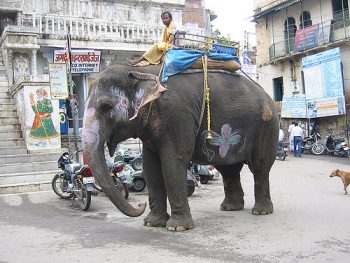Navigating Gender in Hindi (Part 2) Posted by Rachael on Jul 25, 2017 in Hindi Language, Uncategorized
In part 1 of this blog series on gender in Hindi, I discussed gender as it relates to each word’s source language, with the language of focus being Sanskrit. In this post, I’ll talk about a few more source languages and how they dictate gender: Persian, Arabic and English!
Persian and Arabic Nouns
Persian and Arabic words often do not follow the pattern of indigenous Hindi words that end in -aa (आ)=masculine and -i (इ) and -ii (ई)=feminine as these two languages are vastly different from a lot of the languages that are more indigenous to the subcontinent, such as Sanskrit and Prakrit. One helpful tip for these words is to memorize them on a case by case basis, making sure to use flashcards that employ each word in a sentence and state the word’s gender.
Some example sentences:
- इंदिया ने अपनी आज़ादी (fem. noun, Persian) के लिए बहुत कठिन लड़ाई लड़ी । India ne apnee aazaadi ke liye bahut kathin laraai laree. India fought a very difficult battle for its independence.
- आज का मौसम (masc. noun, Arabic) बड़ा अजीब है; लगता है कि एक तूफ़ान (masc. noun, most likely from Arabic or Persian) होनेवाला है । Aaj ka mausam baraa ajeeb hai; lagtaa hai ki ek toofaan honevaalaa hai. The weather today is very strange; it seems that a storm is coming.
- आपकी दास्तान (fem. noun, Persian) सुनकर, वह बहुत ही परेशान (masc. noun, Persian) हो गयी । Aapki daastaan sunkar, voh bahut hi pareshaan ho gayi. After hearing your story, she became extremely distressed.
English Words
The case of gendering English words in Hindi is, as you would expect, a bit tricky as English itself does not have a system of gender and the gendering of such words in Hindi follows sometimes contradictory and seemingly nonexistent rules. Because this is generally the case, it is best to memorize the genders of such words on a case by case basis as well. One rule of thumb is that English words generally adopt the gender of their Hindi equivalents. For example,
- उनकी बेटी के स्कूल की फ़ीस बहुत ज़्यादा बढ़ गयी तो उनको दूसरे स्कूल में उसकी भरती करनी पड़ी । Unki beti ke school ki fees bahut zyaada barh gayi to unko dusre school me uski bharti karni pari. Their daughter’s school fees increased too much, so they had to enroll her in another school.
*Here, one can reason that स्कूल/school is masculine because the “proper” Hindi equivalent, विद्यालय/vidhyaalay, is also masculine. But, फ़ीस/fee is somewhat of an exception in that it is considered feminine, yet the Sanskritic Hindi equivalent, शुल्क/shulk, is masculine.
- रोड़ पर चलते हुए अचानक शर्मा जी के टायर का पंचर हो गया । Ror par chalte hue achaanak Sharma ji ke taayar ka panchar ho gaya. While driving on the road, Sharma ji suddenly got a flat tire.
*रोड़/ror is something you will hear in small cities or villages amongst people who know some English but are not fluent in the language; it is an Indianized pronunciation of “road” that you will not hear amongst those educated primarily in the English language. This word is considered feminine as the equivalent word in Hindi, सड़क/sarak, is also feminine. टायर/taayar (tire) is considered masculine, but there is no ready Hindi equivalent for it. Lastly, पंचर/panchar (puncture, masc. noun) is an Indianized pronunciation of the English word; the Hindi semi-equivalent of this word is simply “hole” or छेद/cched (also masc. noun).
- उसको डॉक्टर के पास जाने के लिये टैक्सी लेनी पड़ी । Usko doctor ke paas jaane ke liye taxi leni pari. He had to take a taxi to see the doctor.
*Doctor is often considered masculine in Hindi as its Sanskritic equivalent चिकित्सक/chikitsak is also masculine. Additionally, “taxi” (टैक्सी) as well as many other forms of transportation (ट्रेन/train, बस/bus, कार/car or गाड़ी/gari/also car but not ट्रक/truck, which is masculine) is feminine, but there is no ready equivalent for taxi in Hindi.
Other common English words in Hindi include the following:
- Bike: बाइक/baaik or साइकिल/saaikil (feminine). No direct Hindi equivalent.
- Cake: केक/kek (masculine). No direct Hindi equivalent.
- Class: क्लास/klaas (feminine). कक्षा/kakshaa (also feminine) is a Sanskritic equivalent.
- Pen: पेन/pen (masculine). कलम/kalam is an equivalent from Arabic (it’s also masculine).
- Shirt: शर्ट/shart (feminine). कमीज़/kameez is an equivalent from Arabic (feminine).
- Pants: पैंट/pent (masculine). पतलून/patloon (masculine) is an equivalent from English as well (pantaloons).
Last but not least…
Another important point is that you should always keep an eye out for EXCEPTION WORDS in the Hindi language because they are commonly used, yet appear to flout normative Hindi gender conventions:
- आदमी/aadmi: man. A word from Arabic, this may explain why this word is actually masculine, despite ending in an -ii (ई), which is often considered feminine in indigenous Hindi words.
- पानी/paani: water. Linguists are still unsure of the origin of this word, but it is definitely considered masculine in Hindi.
- हाथी/haathi: elephant. Also unsure of the origin of this word, but it is likewise considered masculine.
- घी/ghee: clarified butter. Unsure of this word’s origin, but it is, perhaps unexpectedly, masculine.
- मोती/moti: pearl. Masculine, origin unclear.
- दही/dahi: yogurt or curd. Masculine, origin unclear.

Build vocabulary, practice pronunciation, and more with Transparent Language Online. Available anytime, anywhere, on any device.







Comments:
Stephen:
Informative article. Easy to follow. Thanks